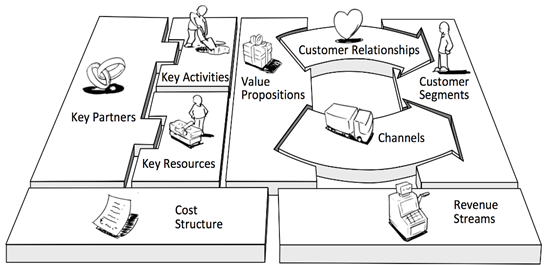Market and Industrialization Opportunities of Rumah Unggul Sistem Panel Instan (RUSPIN) Technology Using Business Model Canvas
DOI:
https://doi.org/10.12928/si.v21i1.58Keywords:
Business Model Canvas, Business Plan, TechnologyAbstract
Rumah Unggul Sistem Panel Instan (RUSPIN) technology is the development of Rumah Instan Sederhana Sehat (RISHA) with several improvements. Besides resistance to earthquakes, this technology has advantages such as ease and speed of installation compared to conventional houses. As a new technological innovation that has been proven, to develop RUSPIN technology to be an industrialization model in the future, therefore a study of technology business plan is required. Research objectives eager to see the market and industrialization opportunities of RUSPIN technology. The study using Business Model Canvas (BMC) concept which strived to combine 9 business aspects such as customer segments, value proposition, channels, customer relationships, revenue streams, key resources, key activities, key partners, and cost structure into one complete concept map. As the result of this study, the market opportunity for RUSPIN technology is very large with the market segmentation is families that do not own a home and the target market for Low-Income Families (MBR). RUSPIN technology also has an opportunity to be industrialized by looking at the demand side (market opportunities), while from the supply side, efforts are needed to increase the number of certified RUSPIN applicators and developers.
References
Ahani, A., Nilashi, M., Ibrahim, O., Sanzogni, L., & Weaven, S. (2019). Market segmentation and travel choice prediction in Spa hotels through TripAdvisor’s online reviews. International Journal of Hospitality Management, 80, 52-77. https://doi.org/10.1016/j.ijhm.2019.01.003.
Ali, H., Zainal, V. R., & Ilhamalimy, R. R. (2021). Determination of Purchase Decisions and Customer Satisfaction: Analysis of Brand Image and Service Quality (Review Literature of Marketing Management). Dinasti International Journal of Digital Business Management, 3(1), 141-153. https://doi.org/10.31933/dijdbm.v3i1.1100.
Badan Standardisasi Nasional. (2012). SNI 1726:2012 Tata Cara Perencanaan Ketahanan Gempa untuk Struktur Bangunan Gedung dan Non Gedung.
Brown, N., & Brown, I. (2019). From digital business strategy to digital transformation-How: A systematic literature review. Proceedings of the South African Institute of Computer Scientists and Information Technologists 2019, 1-8. https://doi.org/10.1145/3351108.3351122.
Dudin, M. N., Lyasnikov, N. V., Leont’eva, L. S., Reshetov, K. J., & Sidorenko, V. N. (2015). Business Model Canvas as a Basis for the Competitive Advantage of Enterprise Structures in the Industrial Agriculture. Biosciences Biotechnology Research Asia, 12(1), 887-894. http://dx.doi.org/10.13005/bbra/1736.
Febrinastri, F., & Fadilah, R. (2021). Teknologi Pracetak untuk Rumah Sederhana Tahan Gempa. https://www.suara.com/bisnis/2021/10/23/080000/teknologi-pracetak-untuk-rumah-sederhana-tahan-gempa.
Furqon, C., Sultan, M., & Wijaya, F. (2019). Business development of coffee farmers group using triple layered business model canvas. J. Bus. Econ. Review, 4(4), 163-170. https://doi.org/10.35609/jber.2019.4.4(3).
Gopinath, K., & Sai, L. P. (2021). A study on the positioning of the brand variants by smartwatch manufacturers: a technometrics approach. Technology Analysis & Strategic Management, 1-15. https://doi.org/10.1080/09537325.2021.1980210.
Hamwi, M., Lizarralde, I., & Legardeur, J. (2021). Demand response business model canvas: A tool for flexibility creation in the electricity markets. Journal of Cleaner Production, 282, 124539. https://doi.org/10.1016/j.jclepro.2020.124539.
Islami, X., Mustafa, N., & Topuzovska Latkovikj, M. (2020). Linking Porter’s generic strategies to firm performance. Future Business Journal, 6, 1-15. https://doi.org/10.1186/s43093-020-0009-1.
Kementerian PUPR. (2019). Kesiapterapan teknologi Rumah Unggul Sistem Panel Instan (RUSPIN). Final Report. Yogyakarta: Balai Penelitian dan Pengembangan Penerapan Teknologi Permukiman.
Osterwalder, A., & Pigneur, Y. (2010). Business Model Generation. Jakarta: PT Elex Media Komputindo. https://opac.perpusnas.go.id/DetailOpac.aspx?id=812801.
Pribadi, K. S., Abduh, M., Kusumaningrum, P., Hasiholan, B., Wirahadikusumah, R. D., & Milyardi, R. (2023). Promoting Humanitarian Engineering Approaches for Earthquake-Resilient Housing in Indonesia. In Transcending Humanitarian Engineering Strategies for Sustainable Futures. 235-262. https://doi.org/10.4018/978-1-6684-5619-4.ch012.
Raya, A. B., Andiani, R., Siregar, A. P., Prasada, I. Y., Indana, F., Simbolon, T. G. Y., Kinasih, A.T., & Nugroho, A. D. (2021). Challenges, open innovation, and engagement theory at craft smes: Evidence from Indonesian batik. Journal of Open Innovation: Technology, Market, and Complexity, 7(2), 121. https://doi.org/10.3390/joitmc7020121.
Rosa, P., Sassanelli, C., & Terzi, S. (2019). Towards Circular Business Models: A systematic literature review on classification frameworks and archetypes. Journal of cleaner production, 236, 117696. https://doi.org/10.1016/j.jclepro.2019.117696.
Setiawan, R. D., Fourqoniah, F., & Aransyah, M. F. (2021). Implementation of Business Road Map as a Development of Business Model Canvas in the Ruang Temu Café in Samarinda. Journal of Business and Management Studies, 3(2), 90-97. https://doi.org/10.32996/jbms.2021.3.2.9.
Sparviero, S. (2019). The case for a socially oriented business model canvas: The social enterprise model canvas. Journal of social entrepreneurship, 10(2), 232-251. https://doi.org/10.1080/19420676.2018.1541011.
Strijker, D., Bosworth, G., & Bouter, G. (2020). Research methods in rural studies: Qualitative, quantitative and mixed methods. Journal of Rural Studies, 78, 262-270. https://doi.org/10.1016/j.jrurstud.2020.06.007.
Umar, A., Sasongko, A. H., & Aguzman, G. (2018). Business Model Canvas as a Solution for Competing Strategy of Small Business in Indonesia. International Journal of Entrepreneurship, 22(1), 1-9. https://www.abacademies.org/articles/.
Velter, M. G. E., Bitzer, V., Bocken, N. M. P., & Kemp, R. (2020). Sustainable business model innovation: The role of boundary work for multi-stakeholder alignment. Journal of Cleaner Production, 247, 119497. https://doi.org/10.1016/j.jclepro.2019.119497.

Downloads
Published
How to Cite
Issue
Section
License
Copyright (c) 2023 Erlita Pramitaningrum, Dimas Hastama Nugraha

This work is licensed under a Creative Commons Attribution-ShareAlike 4.0 International License.









.png)




